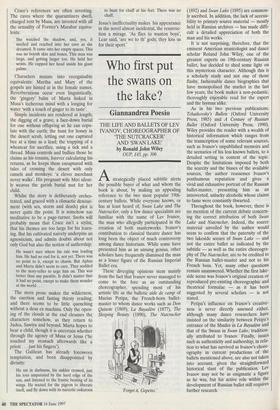Who first put the swans on the lake?
Giannandrea Poesio
THE LIFE AND BALLETS OF LEV IVANOV, CHOREOGRAPHER OF `THE NUTCRACKER' AND 'SWAN LAKE' by Ronald John Wiley OUP, £45, pp. 306 Astrategically placed subtitle alerts the possible buyer of what and whom the book is about, by making an appealing reference to the two most popular 19th- century ballets. While everyone knows, or has at least heard of, Swan Lake and The Nutcracker, only a few dance specialists are familiar with the name of Lev Ivanov, the man who allegedly participated in the creation of both masterworks. Ivanov's contribution to classical theatre dance has long been the object of much controversy among dance historians. While some have presented him as an unsung genius, other scholars have frequently dismissed the man as a lesser figure of the Russian Imperial Ballet era.
These diverging opinions stem mainly from the fact that Ivanov never managed to come to the fore as an outstanding choreographer, spending most of his artistic life as the balletic aide de camp of Marius Petipa, the French-born ballet- master to whom dance works such as Don Quixote (1869), La Bayadere (1877), The Sleeping Beauty (1890), The Nutcracker Forget it, Gepetto.' (1892) and Swan Lake (1895) are common- ly ascribed. In addition, the lack of accessi- bility to primary source material — mostly held in Russian archives — has made diffi- cult a detailed appreciation of both the man and his works.
It is not surprising, therefore, that the eminent American musicologist and dance scholar Roland John Wiley, one of the greatest experts on 19th-century Russian ballet, has decided to shed some light on this mysterious character. Although this is a scholarly study and not one of those flashy, fashionable dance biographies that have monopolised the market in the last few years, the book makes a non-pedantic, thoroughly enjoyable read for the expert and the layman alike.
As in his two previous publications, Tchaikovsky's Ballets (Oxford University Press, 1985) and A Century of Russian Ballet (Oxford University Press, 1990), Wiley provides the reader with a wealth of historical information which ranges from the transcription of some relevant sources, such as Ivanov's unpublished memoirs and the scenarios of his less known ballets, to a detailed setting in context of the topic. Despite the limitations imposed by both the scarcity and the biases of the available sources, the author reassesses Ivanov's posthumous reputation and gives a vivid and exhaustive portrait of the Russian ballet-master, presenting him as an introverted, unlucky alcoholic whose claims to fame were constantly thwarted.
Throughout the book, however, there is no mention of the current debate concern- ing the correct attribution of both Swan Lake and Nutcracker. Indeed, the source material unveiled by the author would seem to confirm that the paternity of the two lakeside scenes of Swan Lake — and not the entire ballet as indicated by the subtitle — as well as the entire choreogra- phy of The Nutcracker, are to be credited to the Russian ballet-master and not to his French boss. Yet, many other questions remain unanswered. Whether the first lake- side scene was Ivanov's original creation or reproduced pre-existing choreographic and theatrical formulae — as it has been suggested by several scholars — is not stated.
Petipa's influence on Ivanov's creative- ness is never directly assessed either, although many dance researchers have insisted on the similarity between Petipa's entrance of the Shades in La Bayadere and that of the Swans in Swan Lake, tradition- ally attributed to Ivanov. Finally, issues such as authenticity and authorship, in rela- tion to what has survived as Ivanov's chore- ography in current productions of the ballets mentioned above, are also not taken into account, given the straightforward historical slant of the publication. Lev Ivanov may not be as enigmatic a figure as he was, but his active role within the development of Russian ballet still requires further research.










































































 Previous page
Previous page